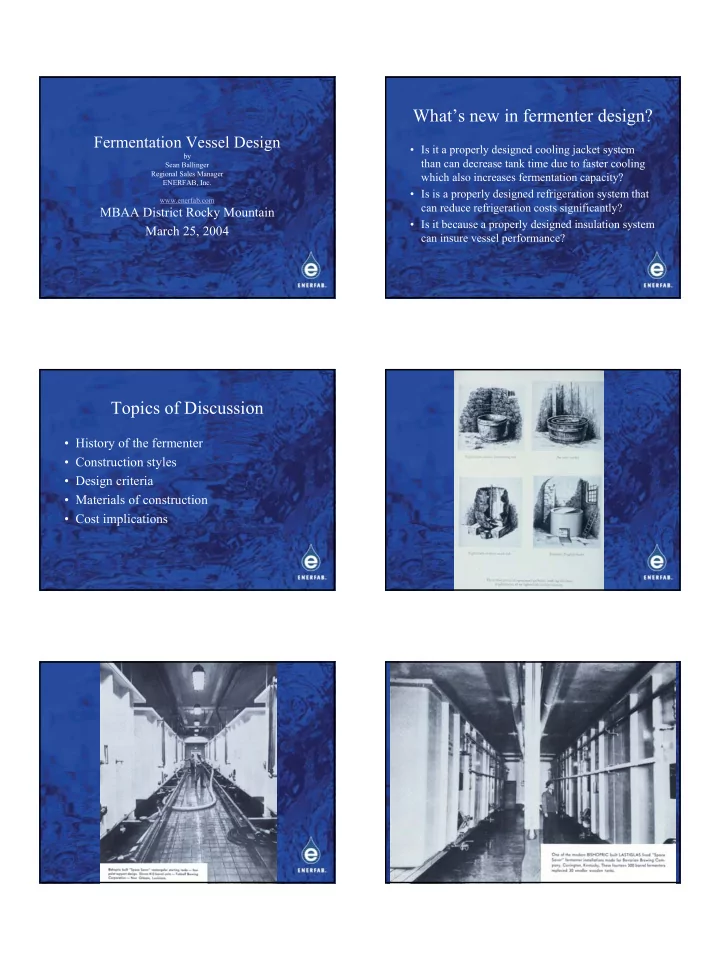

What’s new in fermenter design? Fermentation Vessel Design • Is it a properly designed cooling jacket system by than can decrease tank time due to faster cooling Sean Ballinger Regional Sales Manager which also increases fermentation capacity? ENERFAB, Inc. • Is is a properly designed refrigeration system that www.enerfab.com can reduce refrigeration costs significantly? MBAA District Rocky Mountain • Is it because a properly designed insulation system March 25, 2004 can insure vessel performance? Topics of Discussion • History of the fermenter • Construction styles • Design criteria • Materials of construction • Cost implications 1
2
3
4
5
Fermenter Design Criteria Design Codes Operating conditions consider… • ASME Section VIII, Div. 1 • Pressure and temperature • API 620 • Structural design • API 650 • Vessel support • Heat Transfer Pressure/Vacuum Safety Devices • Dead weight • Spring loaded • Rupture disc • Breaker bar 6
Vertical Fermenter Support Systems • Solid fill foundation • Skirt support • Leg support • Muscle ring/lug supports 7
8
9
Q=“U” x A x T Q = Rate of heat transfer U = Thermal conductivity A = Jacket area T – Temperature difference between beer and coolant 10
28% scale model of the actual production size fermenter 11
Cooling characteristics of Tank Geometry Cost Analysis different cone bottom angles • 2 to 1 H/D vs. a 1 to 1 H/D • 45° angle bottom best performance • 25° angle 2 nd best • Base price approximately the same • 2:1 less material waste for the cone, support • 60° angle slightly worse structure is shorter and smaller compression bars for the top and bottom required • This more than offsets the 6 – 8 % savings in the material, 1:1 requires 10% more jacket for cooling duty Cooling Medium Temperature Total fermenter project costs • 25.5 to 26.6°F produced the best results Building works 19% with no product freezing Tanks and insulation 31% • 22.1°F average temperature caused product Cooling system 15% to freeze at an average product temperature Controls 7% in the fermenter of 37.8°F Piping and valves 13% Electrical 5% Miscellaneous 10% Inuslation Systems • Panel Systems • Pour in Place 12
Refrigeration System Design 13
Cooling System Capital Costs Refrigeration Operating Costs Ammonia: $202,500 • 345 tons (75 tons for three crash cooled fermenters + 120 tons for three other tanks Glycol: $235,500 in various stages) • Ammonia flow rate – 110 GPM = 10 HP pump • Glycol flow rate – 1700 GPM = 100 HP pump Refrigeration Operating Costs Refrigeration Operating Costs • Compressor operation of 39 PSIG compared to • 26.6° F ammonia w/2 PSIG pressure drop in 28.4 PSIG yields 18% compressor power savings suction piping = 39 PSIG compressor • Compressor + pump HP results in savings of suction pressure 45,000 KWH per month, based on 20 day cycle • Glycol supplied at 21° F & returning at 26° for each of the 6 tanks w/2 PSIG pressure drop in suction piping & • 45,000 KWH x 6 cents per kilowatt hour = $2,700 per month or $32,400 a year in operation savings allowing 5° split in glycol chiller = 16° F • A poorly insulated tank farm can cost you ammonia in chiller & 28.4 PSIG additional dollars compressor suction pressure Materials of Construction • 304 stainless steel in 2B or #4 finish • Some brewers are mechanically or elecro- Thank you! polishing the bottom cone • Stainless steel pricing is at a 30-year high due to a variety of factors, China, weak dollar, mine strikes… • Advice to brewers, to plan project well in advance, have the supplier state surcharge and $/lb in the quotation 14
Recommend
More recommend